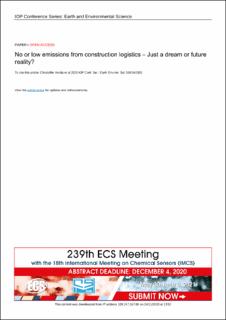| dc.contributor.author | Venås, Christoffer | |
| dc.contributor.author | Flyen, Cecilie | |
| dc.contributor.author | Fufa, Selamawit Mamo | |
| dc.contributor.author | Janné, Mats | |
| dc.contributor.author | Fredriksson, Anna | |
| dc.contributor.author | Brusselaers, Nicolas | |
| dc.contributor.author | Mommens, Koen | |
| dc.contributor.author | Macharis, Cathy | |
| dc.date.accessioned | 2020-11-24T15:49:03Z | |
| dc.date.available | 2020-11-24T15:49:03Z | |
| dc.date.created | 2020-10-16T17:09:52Z | |
| dc.date.issued | 2020 | |
| dc.identifier.issn | 1755-1307 | |
| dc.identifier.uri | https://hdl.handle.net/11250/2689417 | |
| dc.description.abstract | Introduction: Construction sites are among the major sources of greenhouse gas emissions (GHG) in the construction industry. Large quantities of construction materials and other resources need to be transported to, within, and from construction sites. Implementation of different construction logistics solutions can reduce the impact from construction. The objectives of this article are to map the status and present the current practice of construction logistics in Norway, and to discuss how different no or low emission construction logistics solutions can be promoted. Methods: Methods applied are a literature review including findings from the recent development of emission free construction sites and qualitative case study with interviews carried out in Norway. Results: Findings indicate that lack of regulations, specific requirements and awareness, and use of traditional methods to avoid risks are some of the challenges for minimizing impact from construction logistics. However, opportunities are also present; mainly driven by political ambitions, improved environmental requirements in public procurement tenders and market demands and ambitions for reductions in emissions and costs. Preliminary results from interviews in Norway support these findings. Conclusions: The study show that the goal of achieving no or low emission from construction site is possible through setting ambitious requirements, good planning and a close and open collaboration between involved stakeholders. Grant support: This work is part of the Joint Programming Initative (JPI) Urban Europe project "Minimizing impact of construction material flows in cities: Innovative Co-Creation", supported by the national research councils of the participating countries (Sweden, Norway, Austria, Belgium). | en_US |
| dc.language.iso | eng | en_US |
| dc.relation.ispartof | BEYOND 2020 – World Sustainable Built Environment conference | |
| dc.rights | CC BY 3.0 | * |
| dc.rights.uri | https://creativecommons.org/licenses/by/3.0/ | * |
| dc.title | No or low emissions from construction logistics – Just a dream or future reality? | en_US |
| dc.type | Peer reviewed | en_US |
| dc.type | Journal article | en_US |
| dc.description.version | publishedVersion | en_US |
| dc.rights.holder | © 2020 The authors | en_US |
| dc.source.volume | 588 | en_US |
| dc.source.journal | IOP Conference Series: Earth and Environmental Science (EES) | en_US |
| dc.identifier.doi | 10.1088/1755-1315/588/4/042003 | |
| dc.identifier.cristin | 1840259 | |
| dc.relation.project | Norges forskningsråd: 290795 | en_US |
| cristin.ispublished | false | |
| cristin.fulltext | original | |
| cristin.qualitycode | 1 | |

